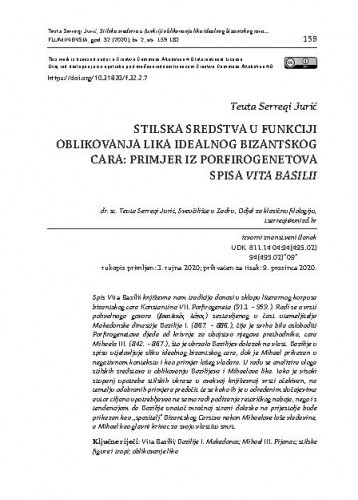Spis Vita Basilii književna nam tradicija donosi u sklopu literarnog korpusa bizantskog cara Konstantina VII. Porfirogeneta (913. ‒ 959.). Radi se o vrsti pohvalnoga govora (βασιλικὸς λόγος) sastavljenog u čast utemeljitelja Makedonske dinastije Bazilija I. (867. ‒ 886.), čija je svrha bila osloboditi Porfirogenetova djeda od krivnje za ubojstvo njegova prethodnika, cara Mihaela III. (842. ‒ 867.), što je ubrzalo Bazilijev dolazak na vlast. Bazilije u spisu utjelovljuje sliku idealnog bizantskog cara, dok je Mihael prikazan u negativnom kontekstu i kao primjer lošeg vladara. U radu se analizira uloga stilskih sredstava u oblikovanju Bazilijeva i Mihaelova lika. Iako je visoki stupanj upotrebe stilskih ukrasa u ovakvoj književnoj vrsti očekivan, na temelju odabranih primjera predočit će se kako ih je u određenim slučajevima autor ciljano upotrebljavao ne samo radi podizanja retoričkog naboja, nego i s tendencijom da Bazilije unatoč mračnoj strani dolaska na prijestolje bude prikazan kao „spasitelj” Bizantskog Carstva nakon Mihaelove loše vladavine, a Mihael kao glavni krivac za svoju vlastitu smrt.; The work Vita Basilii, preserved withing the literary corpus of Byzantine Emperor Constantine VII Porphyrogenitus (913–959), is a panegyric composed in honour of the founder of the Macedonian dynasty, Porphyrogenitus’ grandfather Basil I (867–886). Considering the fact that the work is of a political nature which includes propaganda, and that it was imperative that Basil be exculpated for his role in the assassination of Emperor Michael III (842–867), the author aims to depict Basil as the ideal Byzantine emperor, and Michael as a poor ruler who deserved his death due to his irrational behaviour. In this paper, the role of stylistic means in the characterization of Basil and Michael is analyzed. While a high level of stylistic embellishment in this type of literary genre is to be anticipated, in which its primary role is to heighten rhetorical stylization and affective tension, it can be concluded on the basis of selected examples in the work that in a large number of cases it is the author’s aim to use certain stylistic figures and tropes so that Basil, despite the dark circumstances surrounding his rise to power, is depicted as the “saviour” of the Byzantine Empire after Michael’s poor rulership, and Michael is depicted as the primary guilty party in his own death. Basil is decorated with positive characteristics such as prudence, righteousness, mercy and piety, while Michael is depicted as an emperor who irrationally spends public funds on horse races, drinking binges and feasts, who dishonours holy rituals and murders innocents. In the fashioning of Basil’s character Porphyrogenitus often uses exempla as literary devices (the mother of Persian King Cyrus, Achilles, the hundred-armed giant Briareus, the benevolent father from the parable of the Prodigal Son), using thereby as well other figures, such as hyperbaton, homoeoteleuton, paromoeosis, synonymy, paronomasia, etc.
Sažetak

 Fluminensia : časopis za filološka istraživanja : 32,2(2020) / glavni i odgovorni urednik Aleksandar Mijatović.
Fluminensia : časopis za filološka istraživanja : 32,2(2020) / glavni i odgovorni urednik Aleksandar Mijatović.